人教版(2019)选择性必修第二册Unit 3 Food and Culture Reading and Thinking 课件-(42张ppt)
文档属性
| 名称 | 人教版(2019)选择性必修第二册Unit 3 Food and Culture Reading and Thinking 课件-(42张ppt) | 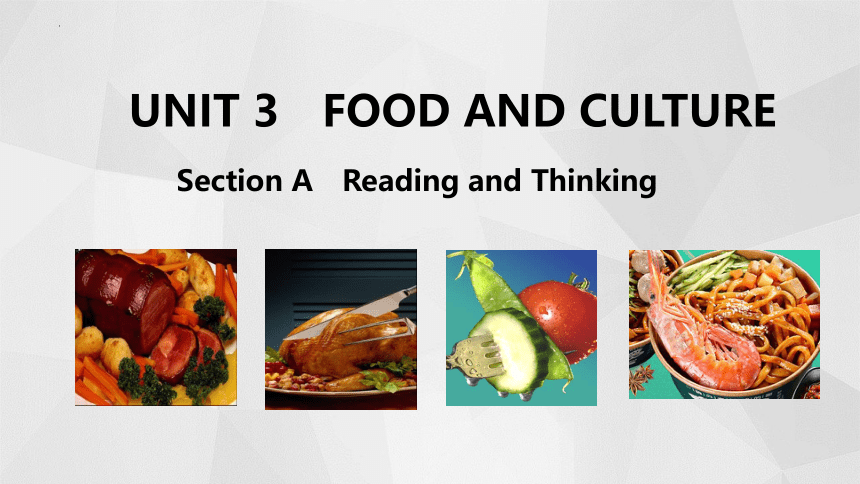 | |
| 格式 | pptx | ||
| 文件大小 | 8.0MB | ||
| 资源类型 | 教案 | ||
| 版本资源 | 人教版(2019) | ||
| 科目 | 英语 | ||
| 更新时间 | 2023-02-27 14:23:31 | ||
图片预览

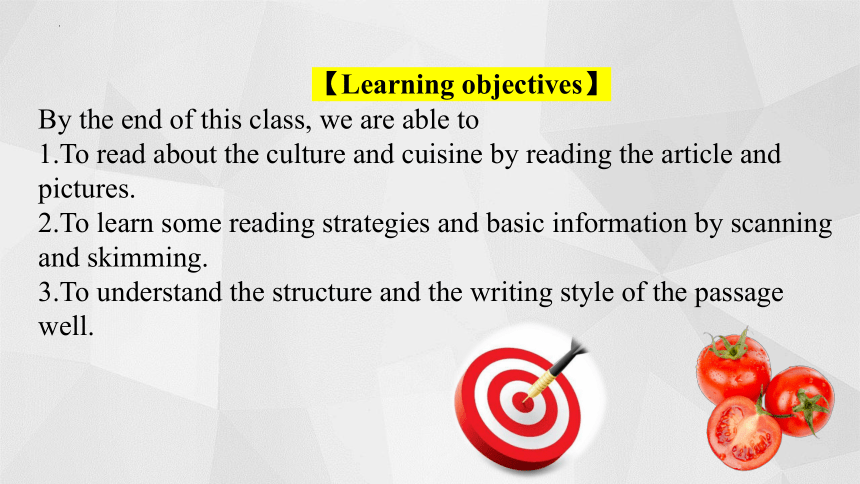
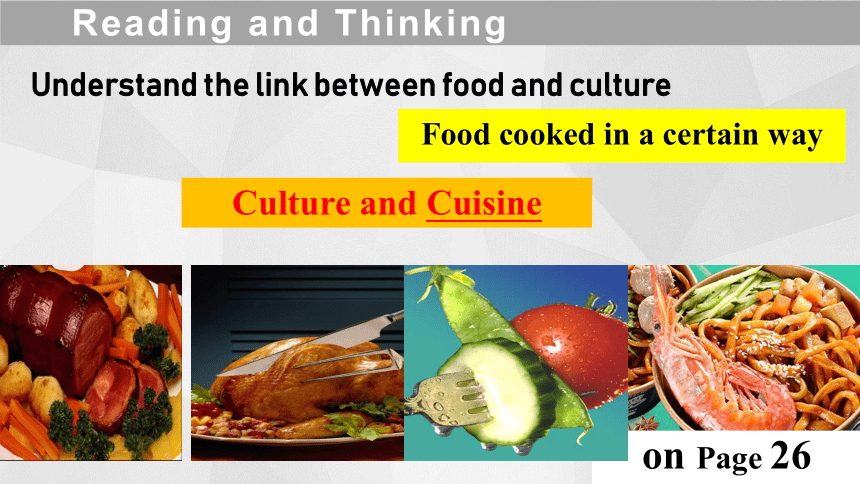
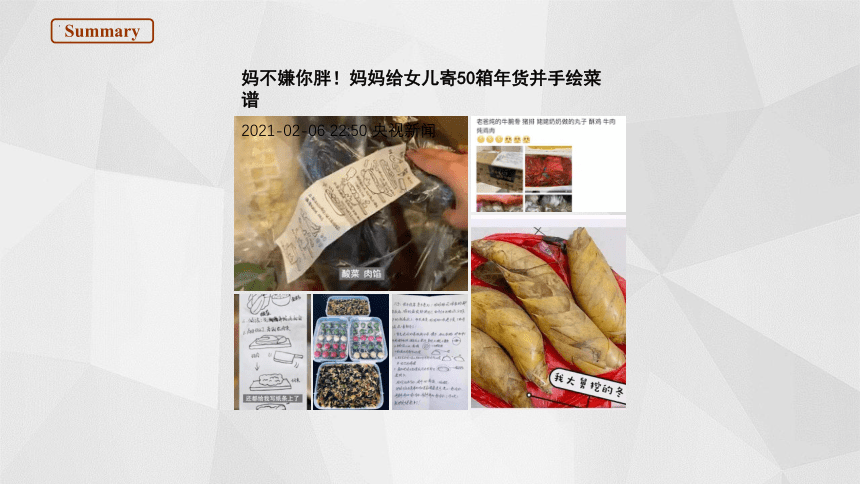
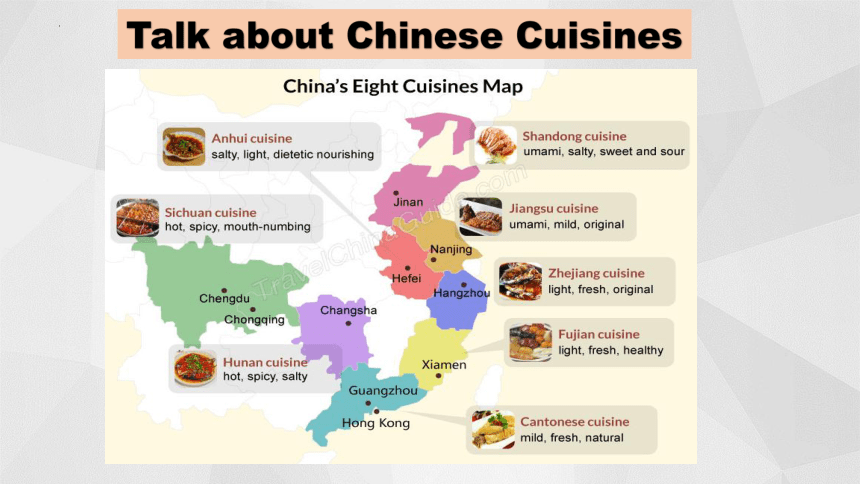
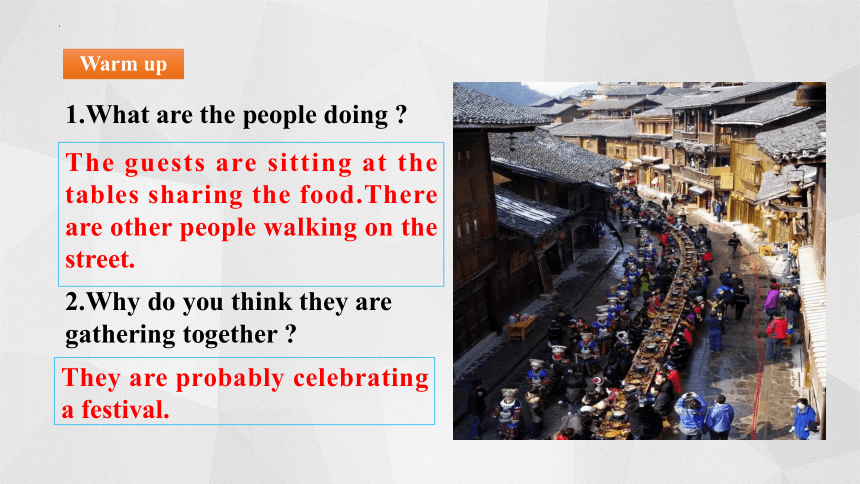
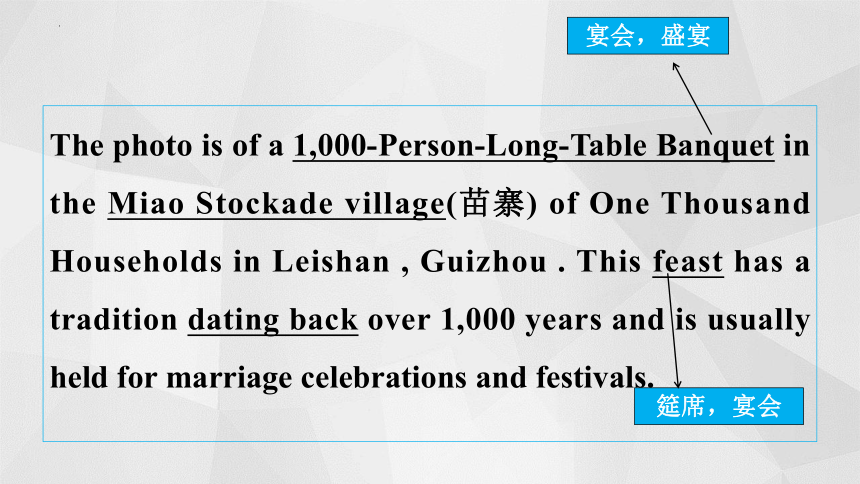
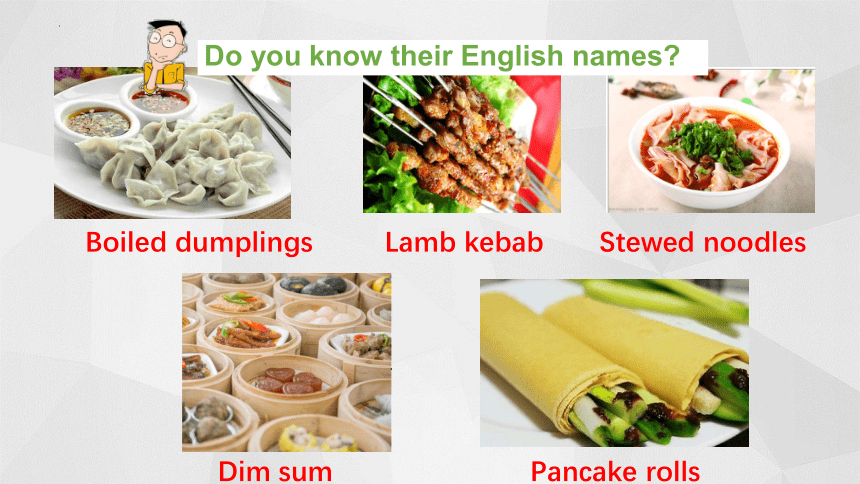
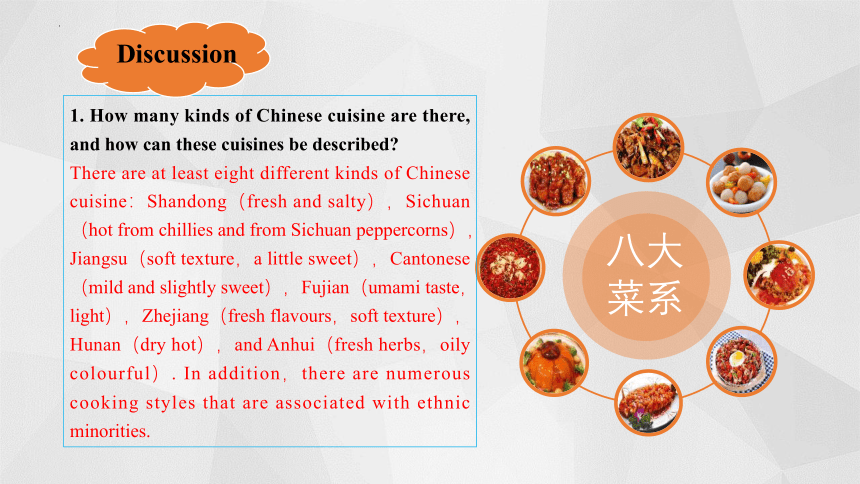
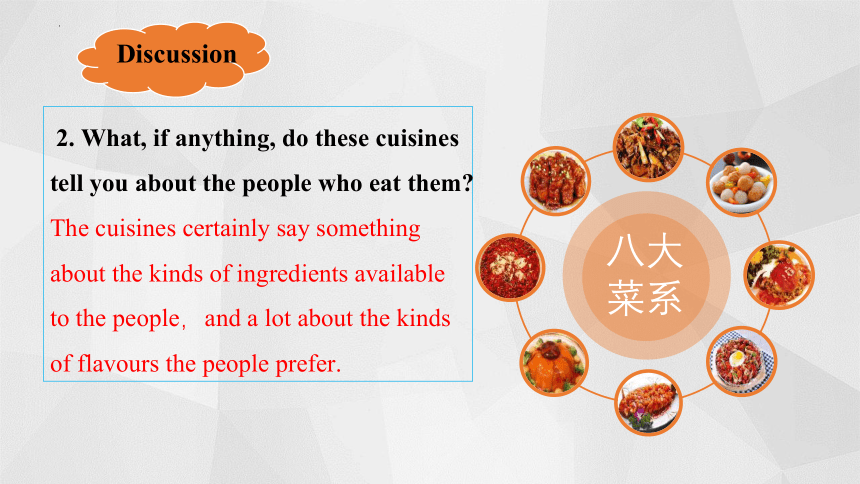
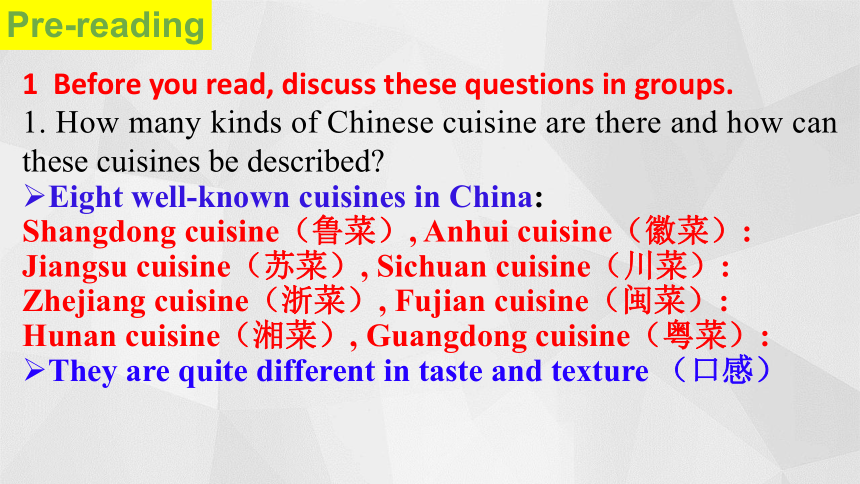
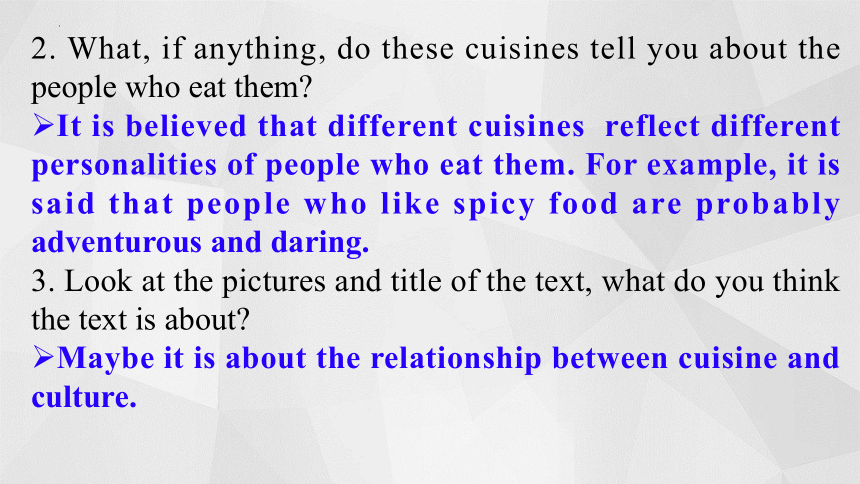
文档简介
(共42张PPT)
UNIT 3 FOOD AND CULTURE
Section A Reading and Thinking
【Learning objectives】
By the end of this class, we are able to
1.To read about the culture and cuisine by reading the article and pictures.
2.To learn some reading strategies and basic information by scanning and skimming.
3.To understand the structure and the writing style of the passage well.
Reading and Thinking
on Page 26
Culture and Cuisine
Understand the link between food and culture
Food cooked in a certain way
妈不嫌你胖!妈妈给女儿寄50箱年货并手绘菜谱
2021-02-06 22:50 央视新闻
Summary
Talk about Chinese Cuisines
2.Why do you think they are gathering together
1.What are the people doing
The guests are sitting at the tables sharing the food.There are other people walking on the street.
They are probably celebrating a festival.
Warm up
The photo is of a 1,000-Person-Long-Table Banquet in the Miao Stockade village(苗寨) of One Thousand Households in Leishan , Guizhou . This feast has a tradition dating back over 1,000 years and is usually held for marriage celebrations and festivals.
筵席,宴会
宴会,盛宴
Boiled dumplings
Lamb kebab
Stewed noodles
Dim sum
Pancake rolls
Do you know their English names
八大
菜系
1. How many kinds of Chinese cuisine are there, and how can these cuisines be described
There are at least eight different kinds of Chinese cuisine:Shandong(fresh and salty),Sichuan(hot from chillies and from Sichuan peppercorns),
Jiangsu(soft texture,a little sweet),Cantonese (mild and slightly sweet),Fujian(umami taste,light),Zhejiang(fresh flavours,soft texture),Hunan(dry hot),and Anhui(fresh herbs,oily colourful). In addition,there are numerous cooking styles that are associated with ethnic minorities.
Discussion
八大
菜系
2. What, if anything, do these cuisines tell you about the people who eat them
The cuisines certainly say something
about the kinds of ingredients available
to the people,and a lot about the kinds
of flavours the people prefer.
Discussion
1 Before you read, discuss these questions in groups.
1. How many kinds of Chinese cuisine are there and how can these cuisines be described
Eight well-known cuisines in China:
Shangdong cuisine(鲁菜), Anhui cuisine(徽菜):
Jiangsu cuisine(苏菜), Sichuan cuisine(川菜):
Zhejiang cuisine(浙菜), Fujian cuisine(闽菜):
Hunan cuisine(湘菜), Guangdong cuisine(粤菜):
They are quite different in taste and texture (口感)
Pre-reading
2. What, if anything, do these cuisines tell you about the people who eat them
It is believed that different cuisines reflect different personalities of people who eat them. For example, it is said that people who like spicy food are probably adventurous and daring.
3. Look at the pictures and title of the text, what do you think the text is about
Maybe it is about the relationship between cuisine and culture.
Textual pattern analysis
Ⅰ 阅读理解(根据课文内容选择正确答案)
1. Where is the writer of the article from
A. Australia. B. England. C. France. D. America.
2. From the passage we can learn the writer and his family visited in China.
A. Three places B. Four places C. Five places D. Six places
3. We can infer from the text that the writer liked .
A. English food B. French food C. American food D. Chinese food
4. By the first visit to China,the writer found the Chinese .
A. bold and hot B. warm-hearted and thoughtful
C. friendly and kind D. hard-working and faithful
○
○
○
○
附:课文预习自测
The French author Jean Anthelme Brillat-Savarin once wrote, “Tell me what you eat, and I will tell you what you are.” Put more simply, this means “You are what you eat.” Most people today relate this saying to healthy eating. However, Brillat-Savarin was referring to our personality, character and culture.
The key sentence of paragraph 1.
Paragraph 1
Q2. The first paragraph has a quote: “You are what you eat.” In pairs, discuss what you think this saying means.
Para1 You are what you eat.
Careful reading
Q1.What’s the purpose of the author using the quote in Para1
To introduce the topic
The saying means that the kind of food we eat tells something about our personality, character, and culture.
The French author Jean Anthelme Brillat-Savarin once wrote, “Tell me what you eat, and I will tell you what you are.” Put more simply, this means “You are what you eat.” Most people today relate this saying to healthy eating. However, Brillat-Savarin was referring to our personality, character and culture.
1. Find out the key sentence of paragraph 1.
2. The first paragraph has a quote: “You are what you eat.” In pairs, discuss what you think this saying means.
Main idea: You are what you eat.
Paragraph 1
1. In pairs, discuss what you think this saying “You are what you eat.” means. (P26, Ex. 2)
The food we eat actually reflects our personality, character, and culture.
2. In what way does the writer show us that culture and cuisine go hand in hand
By sharing hsi different experiences with Chinese cuisine.
Scanning
Certainly, in many ways this seems to be true. Chinese cuisine is a case in point. Prior to coming to China, my only experience with Chinese cooking was in America, with Chinese food that had been changed to suit American tastes. For example, America’s most popular Chinese dish is General Tso’s chicken, which consists of fried chicken covered in a sweet sauce, flavoured with hot red peppers. This is probably not an authentic Chinese recipe,however,so it cannot tell us much about the Chinese. On the other hand,it does tell us a lot about Americans. It tells us, for example, that Americans love bold, simple flavours. And, since the dish was also invented recently, it tells us that Americans are not afraid to try new foods.
In America, what kind of Chinese food did the author once experience
What is America’s most popular Chinese dish
And what can the dish tell us about Americans
The changed Chinese food
Main idea: the first experience with Chinese cuisine in America
Paragraph 2
1. Which is the topic paragraph
The first paragraph
2. Which is the topic sentence
The last sentence of the first paragraph.
3. What is the main idea of the text
It is about different knids of Chinese food and the culture each food represents.
Skimming
4. What type of writing is the text
Expository writing (about cause and effect)
Later I had a chance to experience authentic Chinese food by coming to China. When my family and I had just arrived in China, we went looking for a good place to eat in Beijing. A Sichuan restaurant had been recommended to us by a friend, and finally, we found it. Tired, hungry, and not knowing a word of Chinese, we had no idea how to order, so the chef just began filling our table with the best food we had ever eaten. With this, we had the pleasure of experiencing an entirely new taste: Sichuan peppercorns. The food was wonderful and different, but what was even more important was the friendship offered us.
In Beijing, where did the author and the family enjoy the Chinese food
And in the restaurant, what impressive taste did the author experience
Main idea: the experience with Sichuan cuisine in Beijing
Paragraph 3
We soon moved to Shandong Province in the eastern part of North China. My favourite dish there was boiled dumplings served with vinegar. I observed that family is important to the people there. It has become a favourite traditional dish of the people in North China, where making dumplings has always been a family affair with everyone---from the youngest to the oldest---joining in to help. Later, I learnt that the most famous food in Shandong is pancake rolls stuffed with sliced Chinese green onions.
What is the favourite traditional dish of the people in North China
What can the dish tell us about the people there
Main idea: the experience with Shandong cuisine in Shandong
Paragraph 4
Read Para. 2-6 and discuss in group to find out the places that the author travelled, the cuisines he tasted, and the different personality/culture behind the foods.
Place Kind of Chinese food and typical dish People or culture reflected by food
America
Beijing
Shandong
Northwest China
South China
Central China
Reading & Thinking
Then we moved to northern Xinjiang. Some of our friends were Kazak and Inner Mongolian. These groups traditionally wandered the open range on horses. As a result, their traditional foods are what you can cook over an open fire---usually boiled or roasted meat, such as lamb kebab.
.
1. What is the favourite traditional dish of the people in North China
2.What can the dish tell us about the people there
Main idea: the experience with northwest China cuisine in Xinjiang
Paragraph 5
Task 2 Understand causes and effects. Think about the question.
Why do people living in different places have different kinds of cuisine
Then we moved to northern Xinjiang. Some of our friends were Kazak and Inner Mongolian. These groups traditionally wandered the open range on horse. As a result, their traditional foods are what you can cook over an open fire — usually boiled or roasted meat, such as lamb kebabs.
Para 5
cause
effect
signal word
Our travels then took us to South China, and then on to central China. In each place we went, we experienced wonderful local dishes, from Guangdong’s elegant dim sum---small servings of food in bamboo steamers---to the exceptional stewed noodles in Henan. Everywhere, the food was as varied as the people. However, one thing is always true: Through food, Chinese people everywhere show friendship and kindness.
What kind of Chinese dishes did the author enjoy in South China and Central China
What can we learn about Chinese through food
Main idea: the experience with south and central China cuisine
Paragraph 6
2. In what order is the rest of the passage
organized How do you know
Time order
2. In what order is the rest of the passage
organized How do you know
America
Beijing
Shandong province
northern Xinjiang
South China
South China
Place
order
At a minimum, the kinds of food local people consume tell us what they grow in their region, what kinds of lives they lead, and what they like and do not like. Could we also say, for example, that those who like bold flavours are bold themselves Or, that those who like spicy food tend to have a hot temper Maybe. Maybe not. What we can say, however, is that culture and cuisine go hand in hand, and if you do not experience one, you can never really know the other.
What can the food local people consume tell us
To sum up the main idea of paragraph 7.
It can tell us their region, their life, their preference and their personalities.
Main idea: Culture and cuisine go hand in hand.
Paragraph 7
Place Kind of Chinese food Typical dish People or culture
America
Beijing
Shandong
Chinese food changed to suit American tastes
General Tso's chicken
Americans love bold, simple flavours, and are not afraid to try new foods.
Sichan cuisine
dishes with Sichuan peppercorns
offer them good friendship.
Shandong cuisine
boiled dumplings; pancake rolls stuffed
Family is important to the people there.
3. Use the information to complete the table below.
Detailed reading
Family is important to the people there.
Place Kind of Chinese food Typical dish People or culture
Northwest China
South China
Central China Xinjiang and Inner Mongolian cuisine
boiled or roasted meat
wandered the open range on horses ; cook food over an open fire.
Guangdong cuisine
dim sum
Henan cuisine
stewed noodles
show friendship and kindness.
Discourse Analysis
Para 1: You are what you eat.
Para 2: the first experience with Chinese cuisine in America
Para 3: the experience with Sichuan cuisine in Beijing
Para 4: the experience with Shandong cuisine in Shandong
Para 5: the experience with northwest China cuisine in Xinjiang
Para 6: the experience with south and central China cuisine
Para 7: Culture and cuisine go hand in hand.
General
Particular
General
Pragmatic Analysis
What is the writing purpose of this passage
To introduce the culture and cuisine in China
Who is the intended reader
The people who interested in culture and cuisine
What’s the author’s attitude
He think culture and cuisine have a very close relationship.
Why do people living in different places have different kinds of cuisine
Food
Different places
Culture
① People live in different places, so they share
different local cultures.
② They share different local cultures, as a result,
they have different kinds of food.
cause
effect
cause
effect
1 Do you think “culture and cuisine go hand in hand” Give your reasons.
Yes,because so much of a culture is based up.
Critical-thinking
2.Imagine that it is true that people’s personalities are closely linked to the foods they eat. What does eating the following foods tell you about a person
Possibly,people who like spicy food love excitement and new experiences. And people who like junk food like to enjoy life without worrying about the future.
Critical-thinking
spicy food vegetarian food junk food seafood sweets chocolate rice noodles onion garlic bacon ham sausage cabbage mushroom bean curd
Do you think “culture and cuisine go hand in hand”
Give your reasons.
Yes, because so much of a culture is based upon food and how it is eaten and served.
No, with the impact of globalization, all kinds of food are available everywhere, so food no longer reflects cultures.
In addition, in this fast-changing world, everything is changing, including cuisines.
Discussions
2. Imagine that it is true that people's personalities are closely linked to the foods they eat. What does eating the following foods tell you about a person
spicy food vegetarian food junk food seafood sweets chocolate rice noodles onion garlic bacon ham sausage cabbage mushroom bean curd
Possibly, people who like spicy food love excitement and new experiences. And people who like junk food like to enjoy life without worrying about the future.
Discussions
Phrases
1 put more simply/ (to) put it simply
简单地说,简而言之
2 relate……to……
把……和……联系在一起
3 refer to指的是
4 a case in point 恰当的例子
5 prior to 在……之前的
6 consist of 由……组成(或构成)
7 recommend sth. to sb.
向某人推荐某物
8 fill……with…… 用……装满……
9 boiled dumplings served with vinegar
水饺配醋
10 pancake rolls stuffed with sliced Chinese green onions 煎饼卷大葱
11 lamp kebab 烤羊肉串
12 elegant dim sum 精致的点心
13 exceptional stewed noodles 特色炖面条
14 at a minimum 至少
15 tend to do sth. 易于做某事;倾向于做某事
16 go hand in hand (两件事)密切相关地;携手共进
Phrases
1 put more simply/ (to) put it simply
2 relate……to……
3 refer to
4 a case in point
5 prior to
6 consist of
7 recommend sth. to sb.
8 fill……with……
1 简单地说,简而言之
2 把……和……联系在一起
3 指的是
4 恰当的例子
5 在……之前的
6 由……组成(或构成)
7 向某人推荐某物
8 用……装满……
The French author Jean Anthelme Brillat-Savarin once wrote,“Tell me what you eat, and I will tell you what you are,” 1. means “You are what you eat.” In fact, Brillat-Savarin was actually 2. (refer) to our personality, character, and culture. In many ways, this seems to be true. Chinese cuisine is a case in point. China is a country with vast 3.______(area) and a large population. So the food is as 4. (vary) as the people. For example, people in Shandong like boiled dumplings 5._______(serve) with vinegar, because the process of making dumplings can bring the family members together. 6. (traditional), people in Xinjiang spent most of their time on horse backs, and that is 7.____ they prefer their food to 8. __(cook) over an open fire. In conclusion, through food, Chinese people everywhere show their culture as well as their friendship and 9. (kind). So what we can say is that culture and cuisine go hand 10. hand,and if you do not experience one,you can never really know the other.
which
referring
areas
varied
served
Traditionally
why
be cooked
kindness
in
Ⅱ 语法填空(根据课文内容和语法规则完成短文)
Most people relate “You are what you eat” to healthy eating. It 1 (actual)refers to personality, character, and culture. Chinese cuisine is a case in point. When introduced to America, it 2 (change)to suit American tastes, which tells us Americans like trying new foods.
Later, I visited China and 3 (experience) authentic Chinese food. In Beijing, we ate in a restaurant where the chef treated us to dinner 4 (consist) of Sichuan peppercorns. It was wonderful but what was even more important was the friendship. In Shandong Province, we had 5 (boil)dumplings with vinegar. I found making dumplings is always an affair with the whole family. In South China and central China, I experienced local dishes from Guangdong’s elegant dim sum to the 6 (exception)stewed noodles in Henan. Through food, Chinese people everywhere show friendship and kindness. At
7 minimum, the kinds of food 8 (consume)by local people tell us what they grow in their region, what kinds of lives they lead, and 9 they like and do not like.
All in all, culture and cuisine go hand 10 hand, and if you do not experience one, you can never really know the other.
actually
is changed
experienced
consisting
boiled
exceptional
a
consumed
what
in
THE END
UNIT 3 FOOD AND CULTURE
Section A Reading and Thinking
【Learning objectives】
By the end of this class, we are able to
1.To read about the culture and cuisine by reading the article and pictures.
2.To learn some reading strategies and basic information by scanning and skimming.
3.To understand the structure and the writing style of the passage well.
Reading and Thinking
on Page 26
Culture and Cuisine
Understand the link between food and culture
Food cooked in a certain way
妈不嫌你胖!妈妈给女儿寄50箱年货并手绘菜谱
2021-02-06 22:50 央视新闻
Summary
Talk about Chinese Cuisines
2.Why do you think they are gathering together
1.What are the people doing
The guests are sitting at the tables sharing the food.There are other people walking on the street.
They are probably celebrating a festival.
Warm up
The photo is of a 1,000-Person-Long-Table Banquet in the Miao Stockade village(苗寨) of One Thousand Households in Leishan , Guizhou . This feast has a tradition dating back over 1,000 years and is usually held for marriage celebrations and festivals.
筵席,宴会
宴会,盛宴
Boiled dumplings
Lamb kebab
Stewed noodles
Dim sum
Pancake rolls
Do you know their English names
八大
菜系
1. How many kinds of Chinese cuisine are there, and how can these cuisines be described
There are at least eight different kinds of Chinese cuisine:Shandong(fresh and salty),Sichuan(hot from chillies and from Sichuan peppercorns),
Jiangsu(soft texture,a little sweet),Cantonese (mild and slightly sweet),Fujian(umami taste,light),Zhejiang(fresh flavours,soft texture),Hunan(dry hot),and Anhui(fresh herbs,oily colourful). In addition,there are numerous cooking styles that are associated with ethnic minorities.
Discussion
八大
菜系
2. What, if anything, do these cuisines tell you about the people who eat them
The cuisines certainly say something
about the kinds of ingredients available
to the people,and a lot about the kinds
of flavours the people prefer.
Discussion
1 Before you read, discuss these questions in groups.
1. How many kinds of Chinese cuisine are there and how can these cuisines be described
Eight well-known cuisines in China:
Shangdong cuisine(鲁菜), Anhui cuisine(徽菜):
Jiangsu cuisine(苏菜), Sichuan cuisine(川菜):
Zhejiang cuisine(浙菜), Fujian cuisine(闽菜):
Hunan cuisine(湘菜), Guangdong cuisine(粤菜):
They are quite different in taste and texture (口感)
Pre-reading
2. What, if anything, do these cuisines tell you about the people who eat them
It is believed that different cuisines reflect different personalities of people who eat them. For example, it is said that people who like spicy food are probably adventurous and daring.
3. Look at the pictures and title of the text, what do you think the text is about
Maybe it is about the relationship between cuisine and culture.
Textual pattern analysis
Ⅰ 阅读理解(根据课文内容选择正确答案)
1. Where is the writer of the article from
A. Australia. B. England. C. France. D. America.
2. From the passage we can learn the writer and his family visited in China.
A. Three places B. Four places C. Five places D. Six places
3. We can infer from the text that the writer liked .
A. English food B. French food C. American food D. Chinese food
4. By the first visit to China,the writer found the Chinese .
A. bold and hot B. warm-hearted and thoughtful
C. friendly and kind D. hard-working and faithful
○
○
○
○
附:课文预习自测
The French author Jean Anthelme Brillat-Savarin once wrote, “Tell me what you eat, and I will tell you what you are.” Put more simply, this means “You are what you eat.” Most people today relate this saying to healthy eating. However, Brillat-Savarin was referring to our personality, character and culture.
The key sentence of paragraph 1.
Paragraph 1
Q2. The first paragraph has a quote: “You are what you eat.” In pairs, discuss what you think this saying means.
Para1 You are what you eat.
Careful reading
Q1.What’s the purpose of the author using the quote in Para1
To introduce the topic
The saying means that the kind of food we eat tells something about our personality, character, and culture.
The French author Jean Anthelme Brillat-Savarin once wrote, “Tell me what you eat, and I will tell you what you are.” Put more simply, this means “You are what you eat.” Most people today relate this saying to healthy eating. However, Brillat-Savarin was referring to our personality, character and culture.
1. Find out the key sentence of paragraph 1.
2. The first paragraph has a quote: “You are what you eat.” In pairs, discuss what you think this saying means.
Main idea: You are what you eat.
Paragraph 1
1. In pairs, discuss what you think this saying “You are what you eat.” means. (P26, Ex. 2)
The food we eat actually reflects our personality, character, and culture.
2. In what way does the writer show us that culture and cuisine go hand in hand
By sharing hsi different experiences with Chinese cuisine.
Scanning
Certainly, in many ways this seems to be true. Chinese cuisine is a case in point. Prior to coming to China, my only experience with Chinese cooking was in America, with Chinese food that had been changed to suit American tastes. For example, America’s most popular Chinese dish is General Tso’s chicken, which consists of fried chicken covered in a sweet sauce, flavoured with hot red peppers. This is probably not an authentic Chinese recipe,however,so it cannot tell us much about the Chinese. On the other hand,it does tell us a lot about Americans. It tells us, for example, that Americans love bold, simple flavours. And, since the dish was also invented recently, it tells us that Americans are not afraid to try new foods.
In America, what kind of Chinese food did the author once experience
What is America’s most popular Chinese dish
And what can the dish tell us about Americans
The changed Chinese food
Main idea: the first experience with Chinese cuisine in America
Paragraph 2
1. Which is the topic paragraph
The first paragraph
2. Which is the topic sentence
The last sentence of the first paragraph.
3. What is the main idea of the text
It is about different knids of Chinese food and the culture each food represents.
Skimming
4. What type of writing is the text
Expository writing (about cause and effect)
Later I had a chance to experience authentic Chinese food by coming to China. When my family and I had just arrived in China, we went looking for a good place to eat in Beijing. A Sichuan restaurant had been recommended to us by a friend, and finally, we found it. Tired, hungry, and not knowing a word of Chinese, we had no idea how to order, so the chef just began filling our table with the best food we had ever eaten. With this, we had the pleasure of experiencing an entirely new taste: Sichuan peppercorns. The food was wonderful and different, but what was even more important was the friendship offered us.
In Beijing, where did the author and the family enjoy the Chinese food
And in the restaurant, what impressive taste did the author experience
Main idea: the experience with Sichuan cuisine in Beijing
Paragraph 3
We soon moved to Shandong Province in the eastern part of North China. My favourite dish there was boiled dumplings served with vinegar. I observed that family is important to the people there. It has become a favourite traditional dish of the people in North China, where making dumplings has always been a family affair with everyone---from the youngest to the oldest---joining in to help. Later, I learnt that the most famous food in Shandong is pancake rolls stuffed with sliced Chinese green onions.
What is the favourite traditional dish of the people in North China
What can the dish tell us about the people there
Main idea: the experience with Shandong cuisine in Shandong
Paragraph 4
Read Para. 2-6 and discuss in group to find out the places that the author travelled, the cuisines he tasted, and the different personality/culture behind the foods.
Place Kind of Chinese food and typical dish People or culture reflected by food
America
Beijing
Shandong
Northwest China
South China
Central China
Reading & Thinking
Then we moved to northern Xinjiang. Some of our friends were Kazak and Inner Mongolian. These groups traditionally wandered the open range on horses. As a result, their traditional foods are what you can cook over an open fire---usually boiled or roasted meat, such as lamb kebab.
.
1. What is the favourite traditional dish of the people in North China
2.What can the dish tell us about the people there
Main idea: the experience with northwest China cuisine in Xinjiang
Paragraph 5
Task 2 Understand causes and effects. Think about the question.
Why do people living in different places have different kinds of cuisine
Then we moved to northern Xinjiang. Some of our friends were Kazak and Inner Mongolian. These groups traditionally wandered the open range on horse. As a result, their traditional foods are what you can cook over an open fire — usually boiled or roasted meat, such as lamb kebabs.
Para 5
cause
effect
signal word
Our travels then took us to South China, and then on to central China. In each place we went, we experienced wonderful local dishes, from Guangdong’s elegant dim sum---small servings of food in bamboo steamers---to the exceptional stewed noodles in Henan. Everywhere, the food was as varied as the people. However, one thing is always true: Through food, Chinese people everywhere show friendship and kindness.
What kind of Chinese dishes did the author enjoy in South China and Central China
What can we learn about Chinese through food
Main idea: the experience with south and central China cuisine
Paragraph 6
2. In what order is the rest of the passage
organized How do you know
Time order
2. In what order is the rest of the passage
organized How do you know
America
Beijing
Shandong province
northern Xinjiang
South China
South China
Place
order
At a minimum, the kinds of food local people consume tell us what they grow in their region, what kinds of lives they lead, and what they like and do not like. Could we also say, for example, that those who like bold flavours are bold themselves Or, that those who like spicy food tend to have a hot temper Maybe. Maybe not. What we can say, however, is that culture and cuisine go hand in hand, and if you do not experience one, you can never really know the other.
What can the food local people consume tell us
To sum up the main idea of paragraph 7.
It can tell us their region, their life, their preference and their personalities.
Main idea: Culture and cuisine go hand in hand.
Paragraph 7
Place Kind of Chinese food Typical dish People or culture
America
Beijing
Shandong
Chinese food changed to suit American tastes
General Tso's chicken
Americans love bold, simple flavours, and are not afraid to try new foods.
Sichan cuisine
dishes with Sichuan peppercorns
offer them good friendship.
Shandong cuisine
boiled dumplings; pancake rolls stuffed
Family is important to the people there.
3. Use the information to complete the table below.
Detailed reading
Family is important to the people there.
Place Kind of Chinese food Typical dish People or culture
Northwest China
South China
Central China Xinjiang and Inner Mongolian cuisine
boiled or roasted meat
wandered the open range on horses ; cook food over an open fire.
Guangdong cuisine
dim sum
Henan cuisine
stewed noodles
show friendship and kindness.
Discourse Analysis
Para 1: You are what you eat.
Para 2: the first experience with Chinese cuisine in America
Para 3: the experience with Sichuan cuisine in Beijing
Para 4: the experience with Shandong cuisine in Shandong
Para 5: the experience with northwest China cuisine in Xinjiang
Para 6: the experience with south and central China cuisine
Para 7: Culture and cuisine go hand in hand.
General
Particular
General
Pragmatic Analysis
What is the writing purpose of this passage
To introduce the culture and cuisine in China
Who is the intended reader
The people who interested in culture and cuisine
What’s the author’s attitude
He think culture and cuisine have a very close relationship.
Why do people living in different places have different kinds of cuisine
Food
Different places
Culture
① People live in different places, so they share
different local cultures.
② They share different local cultures, as a result,
they have different kinds of food.
cause
effect
cause
effect
1 Do you think “culture and cuisine go hand in hand” Give your reasons.
Yes,because so much of a culture is based up.
Critical-thinking
2.Imagine that it is true that people’s personalities are closely linked to the foods they eat. What does eating the following foods tell you about a person
Possibly,people who like spicy food love excitement and new experiences. And people who like junk food like to enjoy life without worrying about the future.
Critical-thinking
spicy food vegetarian food junk food seafood sweets chocolate rice noodles onion garlic bacon ham sausage cabbage mushroom bean curd
Do you think “culture and cuisine go hand in hand”
Give your reasons.
Yes, because so much of a culture is based upon food and how it is eaten and served.
No, with the impact of globalization, all kinds of food are available everywhere, so food no longer reflects cultures.
In addition, in this fast-changing world, everything is changing, including cuisines.
Discussions
2. Imagine that it is true that people's personalities are closely linked to the foods they eat. What does eating the following foods tell you about a person
spicy food vegetarian food junk food seafood sweets chocolate rice noodles onion garlic bacon ham sausage cabbage mushroom bean curd
Possibly, people who like spicy food love excitement and new experiences. And people who like junk food like to enjoy life without worrying about the future.
Discussions
Phrases
1 put more simply/ (to) put it simply
简单地说,简而言之
2 relate……to……
把……和……联系在一起
3 refer to指的是
4 a case in point 恰当的例子
5 prior to 在……之前的
6 consist of 由……组成(或构成)
7 recommend sth. to sb.
向某人推荐某物
8 fill……with…… 用……装满……
9 boiled dumplings served with vinegar
水饺配醋
10 pancake rolls stuffed with sliced Chinese green onions 煎饼卷大葱
11 lamp kebab 烤羊肉串
12 elegant dim sum 精致的点心
13 exceptional stewed noodles 特色炖面条
14 at a minimum 至少
15 tend to do sth. 易于做某事;倾向于做某事
16 go hand in hand (两件事)密切相关地;携手共进
Phrases
1 put more simply/ (to) put it simply
2 relate……to……
3 refer to
4 a case in point
5 prior to
6 consist of
7 recommend sth. to sb.
8 fill……with……
1 简单地说,简而言之
2 把……和……联系在一起
3 指的是
4 恰当的例子
5 在……之前的
6 由……组成(或构成)
7 向某人推荐某物
8 用……装满……
The French author Jean Anthelme Brillat-Savarin once wrote,“Tell me what you eat, and I will tell you what you are,” 1. means “You are what you eat.” In fact, Brillat-Savarin was actually 2. (refer) to our personality, character, and culture. In many ways, this seems to be true. Chinese cuisine is a case in point. China is a country with vast 3.______(area) and a large population. So the food is as 4. (vary) as the people. For example, people in Shandong like boiled dumplings 5._______(serve) with vinegar, because the process of making dumplings can bring the family members together. 6. (traditional), people in Xinjiang spent most of their time on horse backs, and that is 7.____ they prefer their food to 8. __(cook) over an open fire. In conclusion, through food, Chinese people everywhere show their culture as well as their friendship and 9. (kind). So what we can say is that culture and cuisine go hand 10. hand,and if you do not experience one,you can never really know the other.
which
referring
areas
varied
served
Traditionally
why
be cooked
kindness
in
Ⅱ 语法填空(根据课文内容和语法规则完成短文)
Most people relate “You are what you eat” to healthy eating. It 1 (actual)refers to personality, character, and culture. Chinese cuisine is a case in point. When introduced to America, it 2 (change)to suit American tastes, which tells us Americans like trying new foods.
Later, I visited China and 3 (experience) authentic Chinese food. In Beijing, we ate in a restaurant where the chef treated us to dinner 4 (consist) of Sichuan peppercorns. It was wonderful but what was even more important was the friendship. In Shandong Province, we had 5 (boil)dumplings with vinegar. I found making dumplings is always an affair with the whole family. In South China and central China, I experienced local dishes from Guangdong’s elegant dim sum to the 6 (exception)stewed noodles in Henan. Through food, Chinese people everywhere show friendship and kindness. At
7 minimum, the kinds of food 8 (consume)by local people tell us what they grow in their region, what kinds of lives they lead, and 9 they like and do not like.
All in all, culture and cuisine go hand 10 hand, and if you do not experience one, you can never really know the other.
actually
is changed
experienced
consisting
boiled
exceptional
a
consumed
what
in
THE END
